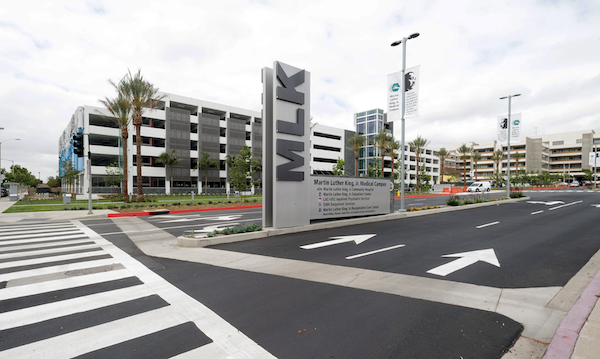A Hospital’s Overflowing Emergency Room, Our Sick Health System
By Mark Kreidler
February 15, 2024
 Last summer, officials at Martin Luther King Jr. Community Hospital in South Los Angeles made a decision: If they didn’t start yelling for help, their facility was headed for a total shutdown.
Last summer, officials at Martin Luther King Jr. Community Hospital in South Los Angeles made a decision: If they didn’t start yelling for help, their facility was headed for a total shutdown.
In the abstract, the problem seemed to make no sense. How could this hospital be in trouble? Not only is MLK (as locals often call it) a newer facility with consecutive five-star ratings from the Centers for Medicare & Medicaid Services, but it also fills a desperate need in a federally certified health care desert and practically overflows with patients.
But the hospital’s reason for being is also undoing it financially. MLK is the only option for most of its patients, and those low-income patients rely on public insurance that doesn’t come close to covering the facility’s costs. MLK won’t survive under these conditions, and scores of thousands of its patients can’t get care elsewhere.
“If the hospital closes, it would leave a profound gap,” said Dyan Sublett, president of the MLK Community Health Foundation, which raises private funding and works with state and local governments on MLK’s financing model. “We need leaders to help make the point that this hospital is too important to fail.”
In January, the Los Angeles County Board of Supervisors heeded those thoughts. Acting on a motion proposed by Supervisor Holly Mitchell, whose district includes the Willowbrook neighborhood where MLK is located, the board approved $20 million in funds for the facility over the next four years. That total includes an $8 million infusion almost immediately.
Where does the county’s help leave the hospital?
“We have until June 2025,” Sublett replied. “By that time, if we don’t see corrective action by the state, we will be insolvent.”
* * *
There are a few things about the MLK situation that make it unlike other safety-net facilities, including how the operation was structured financially when it opened in 2015. But at its heart, the facility’s driving dynamic is very simple: It mostly serves poor people.
Most of the patients cared for at MLK are from lower-income households, and that includes almost all of the patients seen in the emergency department, hospital officials say. And it’s the emergency numbers that have been exploding: Originally built to see about 25,000 emergency patients a year, MLK is on track to treat 125,000 such patients in 2024.
Why does that matter? Because almost all of those emergency patients rely on Medi-Cal, the state’s version of Medicaid, for their care. The hospital thus is reimbursed at Medicaid rates, and California has among the lowest provider payment rates in the nation.
In an op-ed published in 2022, MLK Community Healthcare CEO Elaine Batchlor explained how that plays out on a daily basis. MLK, she wrote, receives about $2,000 from commercial insurance for an emergency department visit. Medicare pays $650 for the same visit. From Medi-Cal, that visit pays just $150.
That means the hospital takes a massive loss on every such publicly insured patient it treats. And because reimbursement rates are so low, few doctors are motivated to work in South L.A. in general, leaving the area with an estimated shortage of 1,500 physicians, Sublett said. Without those physicians working in local clinics or urgent care facilities, more and more patients wind up coming straight to MLK’s emergency department for their health needs.
MLK currently has 63 days of cash on hand, according to an executive summary provided to Capital & Main. That qualifies the hospital at “significantly below junk-bond status,” the report says, leaving it unable to borrow money at reasonable rates.
[READ THE COMPLETE ARTICLE HERE]
